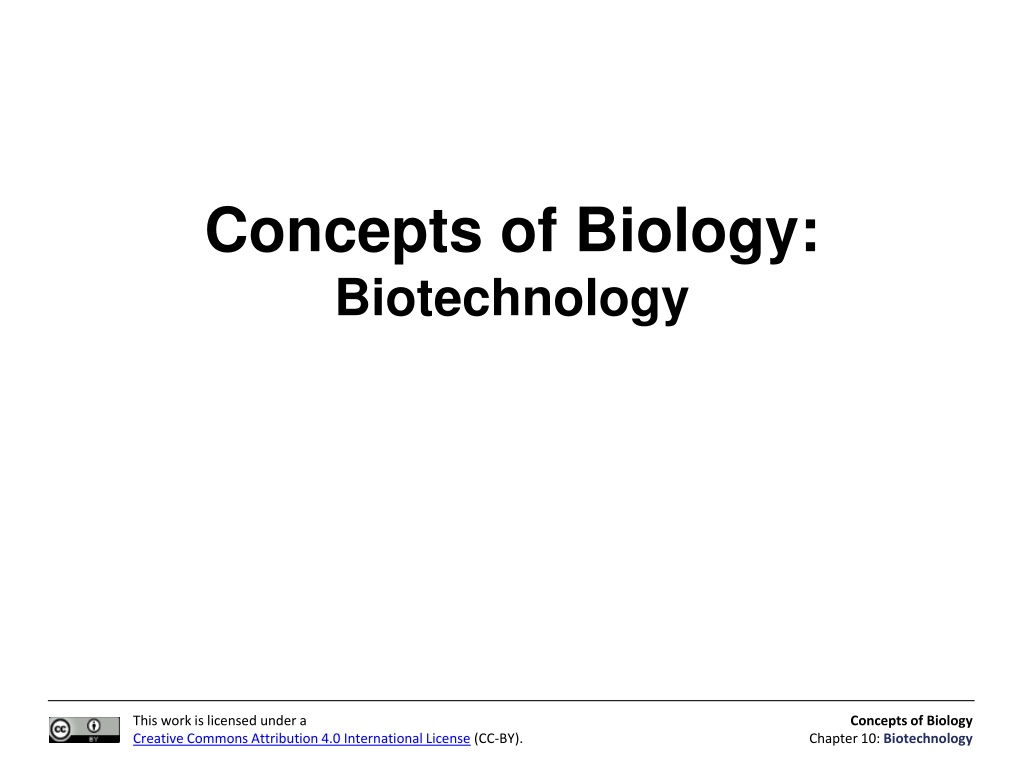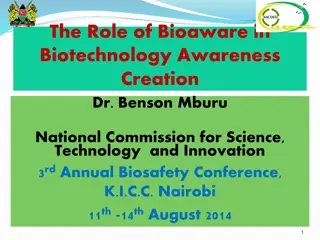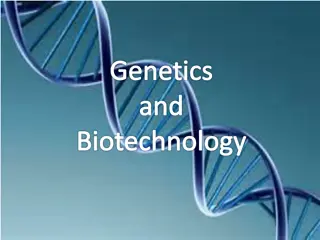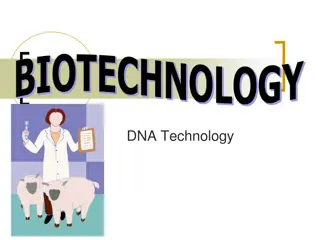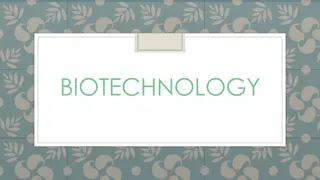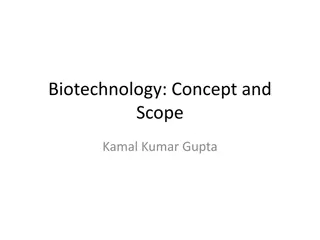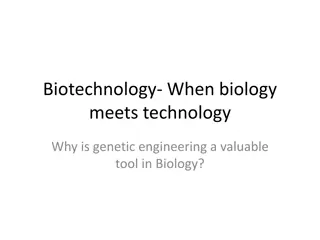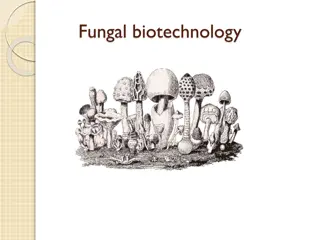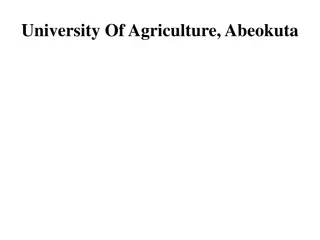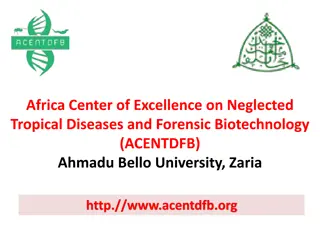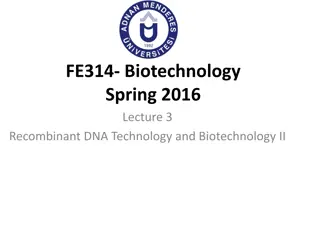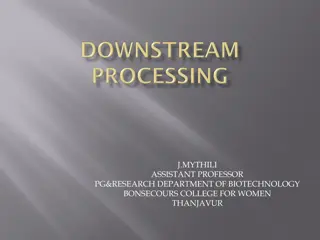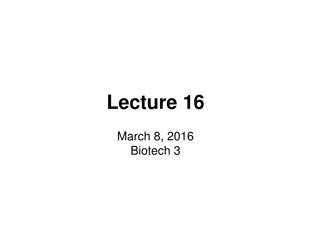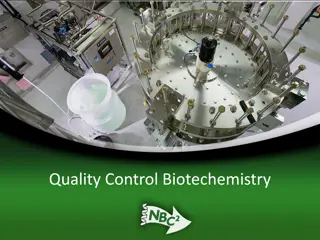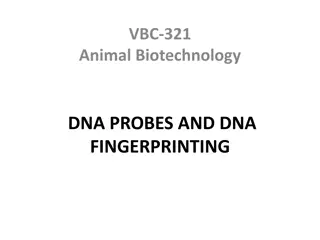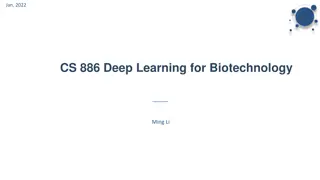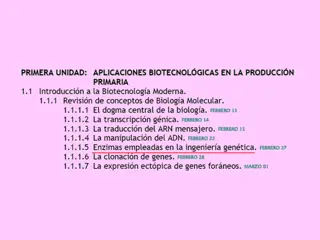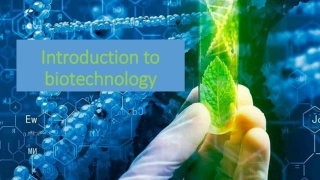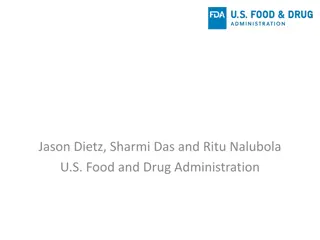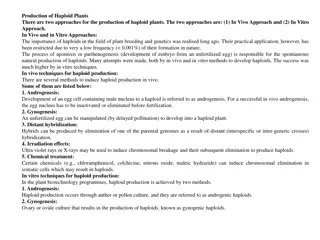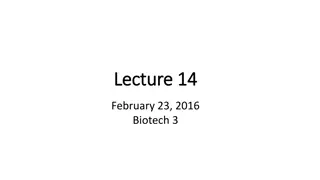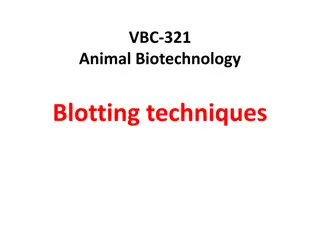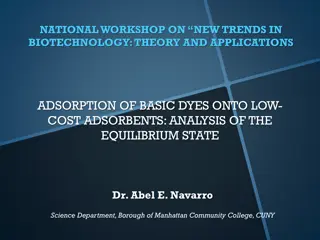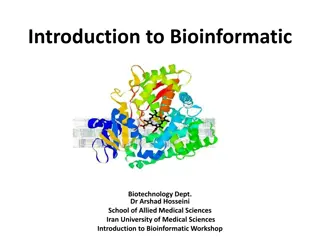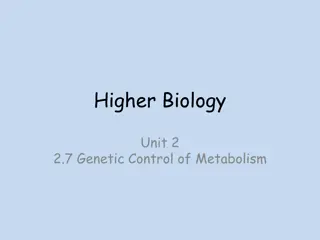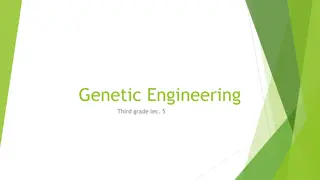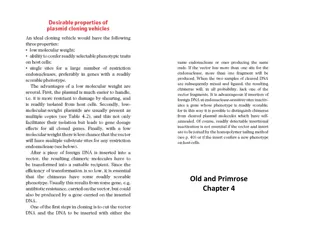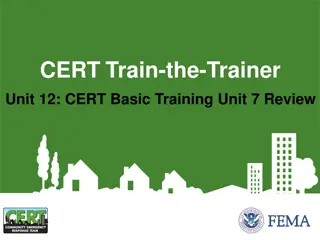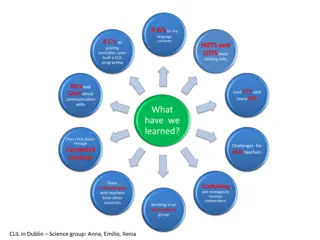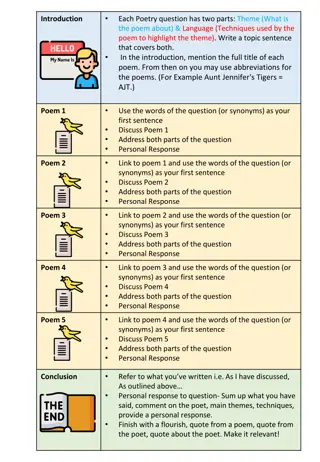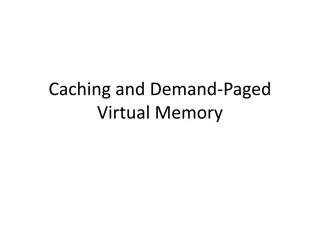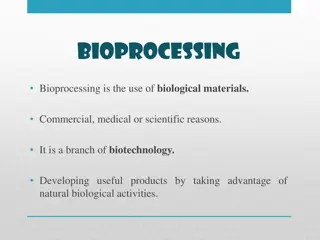Exploring Biotechnology: Concepts and Techniques
Biotechnology encompasses a range of techniques and processes aimed at manipulating biological systems for various applications. This includes methods like PCR for DNA amplification, DNA extraction, gel electrophoresis for DNA fragment analysis, and restriction enzyme processes for DNA manipulation. Through these techniques, researchers can better understand and modify genetic material, leading to advancements in fields like medicine, agriculture, and environmental science.
Download Presentation

Please find below an Image/Link to download the presentation.
The content on the website is provided AS IS for your information and personal use only. It may not be sold, licensed, or shared on other websites without obtaining consent from the author. Download presentation by click this link. If you encounter any issues during the download, it is possible that the publisher has removed the file from their server.
E N D
Presentation Transcript
Concepts of Biology: Biotechnology This work is licensed under a Creative Commons Attribution 4.0 International License (CC-BY). This work is licensed under a Creative Commons Attribution 4.0 International License (CC-BY). Concepts of Biology Chapter 10: Biotechnology Creative Commons Attribution 4.0 International License
(a) A thermal cycler, such as the one shown here, is a basic tool used to study DNA in a process called the polymerase chain reaction (PCR). The polymerase enzyme most often used with PCR comes from a strain of bacteria that lives in (b) the hot springs of Yellowstone National Park. (Credit a: modification of work by Magnus Manske; credit b: modification of work by Jon Sullivan) This work is licensed under a Creative Commons Attribution 4.0 International License (CC-BY). This work is licensed under a Creative Commons Attribution 4.0 International License (CC-BY). Concepts of Biology Chapter 10: Biotechnology Creative Commons Attribution 4.0 International License
This diagram shows the basic method used for the extraction of DNA. This work is licensed under a Creative Commons Attribution 4.0 International License (CC-BY). This work is licensed under a Creative Commons Attribution 4.0 International License (CC-BY). Concepts of Biology Chapter 10: Biotechnology Creative Commons Attribution 4.0 International License
Shown are DNA fragments from six samples run on a gel, stained with a fluorescent dye and viewed under UV light. (Credit: modification of work by James Jacob, Tompkins Cortland Community College) This work is licensed under a Creative Commons Attribution 4.0 International License (CC-BY). This work is licensed under a Creative Commons Attribution 4.0 International License (CC-BY). Concepts of Biology Chapter 10: Biotechnology Creative Commons Attribution 4.0 International License
Polymerase chain reaction, or PCR, is used to produce many copies of a specific sequence of DNA using a special form of DNA polymerase. This work is licensed under a Creative Commons Attribution 4.0 International License (CC-BY). This work is licensed under a Creative Commons Attribution 4.0 International License (CC-BY). Concepts of Biology Chapter 10: Biotechnology Creative Commons Attribution 4.0 International License
In this (a) six-nucleotide restriction enzyme recognition site, notice that the sequence of six nucleotides reads the same in the 5' to 3' direction on one strand as it does in the 5' to 3' direction on the complementary strand. This is known as a palindrome. (b) The restriction enzyme makes breaks in the DNA strands, and (c) the cut in the DNA results in sticky ends . Another piece of DNA cut on either end by the same restriction enzyme could attach to these sticky ends and be inserted into the gap made by this cut. This work is licensed under a Creative Commons Attribution 4.0 International License (CC-BY). This work is licensed under a Creative Commons Attribution 4.0 International License (CC-BY). Concepts of Biology Chapter 10: Biotechnology Creative Commons Attribution 4.0 International License
This diagram shows the steps involved in molecular cloning. This work is licensed under a Creative Commons Attribution 4.0 International License (CC-BY). This work is licensed under a Creative Commons Attribution 4.0 International License (CC-BY). Concepts of Biology Chapter 10: Biotechnology Creative Commons Attribution 4.0 International License
Dolly the sheep was the first agricultural animal to be cloned. To create Dolly, the nucleus was removed from a donor egg cell. The enucleated egg was placed next to the other cell, then they were shocked to fuse. They were shocked again to start division. The cells were allowed to divide for several days until an early embryonic stage was reached, before being implanted in a surrogate mother. This work is licensed under a Creative Commons Attribution 4.0 International License (CC-BY). This work is licensed under a Creative Commons Attribution 4.0 International License (CC-BY). Concepts of Biology Chapter 10: Biotechnology Creative Commons Attribution 4.0 International License
CONCEPT IN ACTION Watch this short video explaining how scientists create a transgenic animal. http://www.learner.org/courses/biology/arch ive/animations/hires/a_gmo3_h.html This work is licensed under a Creative Commons Attribution 4.0 International License (CC-BY). This work is licensed under a Creative Commons Attribution 4.0 International License (CC-BY). Concepts of Biology Chapter 10: Biotechnology Creative Commons Attribution 4.0 International License
CONCEPT IN ACTION See how human DNA is extracted for uses such as genetic testing. http://learn.genetics.utah.edu/content/labs/ extraction/ This work is licensed under a Creative Commons Attribution 4.0 International License (CC-BY). This work is licensed under a Creative Commons Attribution 4.0 International License (CC-BY). Concepts of Biology Chapter 10: Biotechnology Creative Commons Attribution 4.0 International License
This diagram shows the steps involved in curing disease with gene therapy using an adenovirus vector. (Credit: modification of work by NIH) This work is licensed under a Creative Commons Attribution 4.0 International License (CC-BY). This work is licensed under a Creative Commons Attribution 4.0 International License (CC-BY). Concepts of Biology Chapter 10: Biotechnology Creative Commons Attribution 4.0 International License
It can be seen that two of these mice are transgenic because they have a gene that causes them to fluoresce under a UV light. The non-transgenic mouse does not have the gene that causes fluorescence. (Credit: Ingrid Moen et al.) This work is licensed under a Creative Commons Attribution 4.0 International License (CC-BY). This work is licensed under a Creative Commons Attribution 4.0 International License (CC-BY). Concepts of Biology Chapter 10: Biotechnology Creative Commons Attribution 4.0 International License
Corn, a major agricultural crop used to create products for a variety of industries, is often modified through plant biotechnology. (Credit: Keith Weller, USDA) This work is licensed under a Creative Commons Attribution 4.0 International License (CC-BY). This work is licensed under a Creative Commons Attribution 4.0 International License (CC-BY). Concepts of Biology Chapter 10: Biotechnology Creative Commons Attribution 4.0 International License
This is a physical map of the human X chromosome. (Credit: modification of work by NCBI, NIH) This work is licensed under a Creative Commons Attribution 4.0 International License (CC-BY). This work is licensed under a Creative Commons Attribution 4.0 International License (CC-BY). Concepts of Biology Chapter 10: Biotechnology Creative Commons Attribution 4.0 International License
CONCEPT IN ACTION Online Mendelian Inheritance in Man (OMIM) is a searchable online catalog of human genes and genetic disorders. This website shows genome mapping, and also details the history and research of each trait and disorder. Click the link to search for traits (such as handedness) and genetic disorders (such as diabetes). http://openstaxcollege.org/l/OMIM2 This work is licensed under a Creative Commons Attribution 4.0 International License (CC-BY). This work is licensed under a Creative Commons Attribution 4.0 International License (CC-BY). Concepts of Biology Chapter 10: Biotechnology Creative Commons Attribution 4.0 International License
This work is licensed under a Creative Commons Attribution 4.0 International License (CC-BY). This work is licensed under a Creative Commons Attribution 4.0 International License (CC-BY). Concepts of Biology Chapter 10: Biotechnology Creative Commons Attribution 4.0 International License
Metagenomics involves isolating DNA from multiple species within an environmental niche. The DNA is cut up and sequenced, allowing entire genome sequences of multiple species to be reconstructed from the sequences of overlapping pieces. This work is licensed under a Creative Commons Attribution 4.0 International License (CC-BY). This work is licensed under a Creative Commons Attribution 4.0 International License (CC-BY). Concepts of Biology Chapter 10: Biotechnology Creative Commons Attribution 4.0 International License
Renewable fuels were tested in Navy ships and aircraft at the first Naval Energy Forum. (Credit: modification of work by John F. Williams, US Navy) This work is licensed under a Creative Commons Attribution 4.0 International License (CC-BY). This work is licensed under a Creative Commons Attribution 4.0 International License (CC-BY). Concepts of Biology Chapter 10: Biotechnology Creative Commons Attribution 4.0 International License
Bacillus anthracis is the organism that causes anthrax. (Credit: modification of work by CDC; scale-bar data from Matt Russell) This work is licensed under a Creative Commons Attribution 4.0 International License (CC-BY). This work is licensed under a Creative Commons Attribution 4.0 International License (CC-BY). Concepts of Biology Chapter 10: Biotechnology Creative Commons Attribution 4.0 International License
Transgenic agricultural plants can be made to resist disease. These transgenic plums are resistant to the plum pox virus. (Credit: Scott Bauer, USDA ARS) This work is licensed under a Creative Commons Attribution 4.0 International License (CC-BY). This work is licensed under a Creative Commons Attribution 4.0 International License (CC-BY). Concepts of Biology Chapter 10: Biotechnology Creative Commons Attribution 4.0 International License
This machine is preparing to do a proteomic pattern analysis to identify specific cancers so that an accurate cancer prognosis can be made. (Credit: Dorie Hightower, NCI, NIH) This work is licensed under a Creative Commons Attribution 4.0 International License (CC-BY). This work is licensed under a Creative Commons Attribution 4.0 International License (CC-BY). Concepts of Biology Chapter 10: Biotechnology Creative Commons Attribution 4.0 International License
LTS Activity http://outreach.letstalkscience.ca/componen t/zoo/item/diy-activities-3.html This work is licensed under a Creative Commons Attribution 4.0 International License (CC-BY). This work is licensed under a Creative Commons Attribution 4.0 International License (CC-BY). Concepts of Biology Chapter 10: Biotechnology Creative Commons Attribution 4.0 International License
